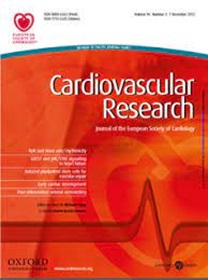A multi-omics approach uncovers causality of IL6R on endotypes of subclinical carotid atherosclerosis and the possible role of the IL6R/OSMR pathway.
IF 13.3
1区 医学
Q1 CARDIAC & CARDIOVASCULAR SYSTEMS
引用次数: 0
Abstract
AIMS Endotypes integrate individual clinical and molecular data and can be used to formulate molecular subclassifications of diseases. We previously derived four endotypes of subclinical carotid atherosclerosis in a large European cohort, c-IMT and c-IMT Progression as Predictors of Vascular Events in a High-Risk European Population (IMPROVE), identifying individuals with a specific cardiovascular (CV) risk, ranging from low (endotype 1) to very high (endotype 4). Here, we investigate the mechanisms underlying the differences in CV risk observed across these four endotypes. METHODS AND RESULTS We validated the four endotypes in SCAPIS (n = 5050) and UK Biobank (n = 50 396) using carotid plaque and carotid intima-media thickness (c-IMT) as subclinical atherosclerosis measures. Endotype 4 associated with a larger number of carotid plaques and increased c-IMT measures as compared to endotype 1. We performed a meta-analysis of individual genome wide association studies in IMPROVE (n = 3711), SCAPIS and UK Biobank, and identified 12 SNPs associated with endotypes. We investigated if they regulated gene expression and circulating protein levels. We found that rs2228145A/C at Interleukin-6 Receptor (IL6R), associated with endotype 4, regulated IL6R expression and circulating levels of OncoStatin M Receptor (OSMR), Complement Factor B (CFB) and Fibrinogen Chain A (FGA). We used rs2228145A/C as an instrument in two-sample Mendelian randomization analyses and showed that a decreasing IL6R expression, associated with increasing CFB, FGA, and OSMR circulating levels. Endotype 4, IL6R, CFB, FGA, and OSMR co-localized within 250 kb surrounding rs2228145A/C. However, only OSMR was up-regulated in advanced carotid atherosclerotic plaques in the presence of the A allele and in aortic region exposed to low wall shear stress. In the UK Biobank, we observed that each additional A allele at rs2228145 increased by 1.28-times the risk of myocardial infarction (MI) in endotype 4. CONCLUSION Rs2228145A/C associated with endotype 4 clinical and molecular characteristics and amplified the MI risk in individuals assigned to endotype 4. These effects appeared to be mediated by a crosstalk with OSMR.多组学方法揭示了IL6R对亚临床颈动脉粥样硬化内型的因果关系以及IL6R/OSMR通路的可能作用。
AIMSEndotypes整合了个体临床和分子数据,可用于制定疾病的分子亚分类。我们之前在一个大型欧洲队列中得出了四种亚临床颈动脉粥样硬化的内分型,c-IMT和c-IMT进展作为高危欧洲人群血管事件的预测因子(改善),确定了具有特定心血管(CV)风险的个体,范围从低(内分型1)到高(内分型4)。在这里,我们研究了在这四种内型中观察到的CV风险差异的机制。方法和结果我们用颈动脉斑块和颈动脉内膜-中膜厚度(c-IMT)作为亚临床动脉粥样硬化指标,在SCAPIS (n = 5050)和UK Biobank (n = 50396)中验证了四种内皮型。与Endotype 1相比,Endotype 4与颈动脉斑块数量增加和c-IMT测量增加相关。我们在IMPROVE (n = 3711)、SCAPIS和UK Biobank中对个体基因组全关联研究进行了荟萃分析,并确定了12个与内型相关的snp。我们研究了它们是否调节基因表达和循环蛋白水平。我们发现与内皮型4相关的白细胞介素-6受体(IL6R)位点rs2228145A/C调节IL6R的表达和OncoStatin M受体(OSMR)、补体因子B (CFB)和纤维蛋白原链A (FGA)的循环水平。我们使用rs2228145A/C作为两样本孟德尔随机化分析的工具,发现IL6R表达的降低与循环CFB、FGA和OSMR水平的增加有关。Endotype 4、IL6R、CFB、FGA和OSMR共同定位在rs2228145A/C周围的250kb范围内。然而,只有在A等位基因存在的晚期颈动脉粥样硬化斑块中,以及在低壁剪切应力下的主动脉区域,OSMR被上调。在UK Biobank中,我们观察到rs2228145位点每增加一个A等位基因,内源性4型患者心肌梗死(MI)的风险增加1.28倍。结论rs2228145a /C与内啡肽4型患者的临床和分子特征相关,并增加了内啡肽4型患者心肌梗死的风险。这些效应似乎是由OSMR的串扰介导的。
本文章由计算机程序翻译,如有差异,请以英文原文为准。
求助全文
约1分钟内获得全文
求助全文
来源期刊

Cardiovascular Research
医学-心血管系统
CiteScore
21.50
自引率
3.70%
发文量
547
审稿时长
1 months
期刊介绍:
Cardiovascular Research
Journal Overview:
International journal of the European Society of Cardiology
Focuses on basic and translational research in cardiology and cardiovascular biology
Aims to enhance insight into cardiovascular disease mechanisms and innovation prospects
Submission Criteria:
Welcomes papers covering molecular, sub-cellular, cellular, organ, and organism levels
Accepts clinical proof-of-concept and translational studies
Manuscripts expected to provide significant contribution to cardiovascular biology and diseases
 求助内容:
求助内容: 应助结果提醒方式:
应助结果提醒方式:


